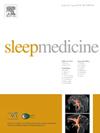Same scale, different names? An assessment of the psychometric properties of three established scales that measure cognitive processes in insomnia, and the introduction of the sleep worry 7 questionnaire
IF 3.4
2区 医学
Q1 CLINICAL NEUROLOGY
引用次数: 0
Abstract
Background
Previous reports have highlighted the abundance of cognitive constructs in insomnia research as a growing issue. Several questionnaires that measure sleep-related cognitions have been developed and there are indications of conceptual overlap between different cognitive constructs and the questions used to operationalize them.
Objectives
This study examines the convergent validity of three established questionnaires measuring cognitive processes in insomnia: the Anxiety and Preoccupation about Sleep Questionnaire (APSQ), the Dysfunctional Beliefs and Attitudes about Sleep Scale (DBAS-10), and the Pre-Sleep Arousal Scale (PSAS-C). Another objective was to explore how a briefer scale can be structured as well as to investigate this scale's ability to predict incident and persistent insomnia compared to the established scales.
Methods
2333 participants from the general population completed surveys on insomnia symptoms and cognitive processes at baseline and 18 months later. Confirmatory factor analysis was used to investigate the scales' conceptual overlap as well as distinctive factors. An exploratory factor analysis was conducted to investigate the underlying factor structure of the items from the APSQ, the DBAS-10 and the PSAS-C. This analysis formed the basis of the creation of a new short scale: Sleep Worry 7. Binary logistic regressions were used to assess all scales’ abilities to predict incident and persistent insomnia.
Results and conclusions
The overlap between the three scales was neither large enough to conclude that they are measuring the same construct, nor could it be confirmed that they measure three distinct questionnaire-specific cognitive processes within insomnia. The brief scale created within this study was able to predict persistent insomnia at similar levels to the three established scales combined, indicating that it captures important cognitions involved in the maintenance of insomnia. Measuring sleep-related cognitions with fewer items might be beneficial in both clinical contexts and research.
相同的音阶,不同的名字?对三种已建立的测量失眠症认知过程的量表的心理测量特性进行评估,并引入睡眠担忧问卷
以前的报告强调了失眠研究中认知结构的丰富性是一个日益增长的问题。一些测量睡眠相关认知的问卷已经被开发出来,有迹象表明,不同的认知结构和用于操作它们的问题之间存在概念重叠。目的探讨已编制的睡眠焦虑与关注问卷(APSQ)、睡眠功能失调信念与态度量表(DBAS-10)和睡眠前觉醒量表(PSAS-C)在失眠认知过程中的收敛效度。另一个目标是探索如何构建一个简短的量表,并研究与现有量表相比,该量表预测偶发性和持续性失眠的能力。方法2333名普通人群在基线和18个月后完成失眠症状和认知过程的调查。采用验证性因子分析探讨量表的概念重叠和显著性因素。通过探索性因子分析探讨了APSQ、DBAS-10和PSAS-C项目的潜在因子结构。这种分析形成了一个新的短量表的基础:睡眠焦虑7。采用二元逻辑回归来评估所有量表预测偶发性和持续性失眠的能力。结果和结论三个量表之间的重叠既没有大到足以断定它们测量的是相同的结构,也不能证实它们测量的是失眠中三个不同的问卷特定的认知过程。在这项研究中创建的简短量表能够预测持续失眠,其水平与三个已建立的量表的总和相似,表明它捕获了与失眠维持有关的重要认知。用更少的项目来测量与睡眠相关的认知可能在临床环境和研究中都是有益的。
本文章由计算机程序翻译,如有差异,请以英文原文为准。
求助全文
约1分钟内获得全文
求助全文
来源期刊

Sleep medicine
医学-临床神经学
CiteScore
8.40
自引率
6.20%
发文量
1060
审稿时长
49 days
期刊介绍:
Sleep Medicine aims to be a journal no one involved in clinical sleep medicine can do without.
A journal primarily focussing on the human aspects of sleep, integrating the various disciplines that are involved in sleep medicine: neurology, clinical neurophysiology, internal medicine (particularly pulmonology and cardiology), psychology, psychiatry, sleep technology, pediatrics, neurosurgery, otorhinolaryngology, and dentistry.
The journal publishes the following types of articles: Reviews (also intended as a way to bridge the gap between basic sleep research and clinical relevance); Original Research Articles; Full-length articles; Brief communications; Controversies; Case reports; Letters to the Editor; Journal search and commentaries; Book reviews; Meeting announcements; Listing of relevant organisations plus web sites.
 求助内容:
求助内容: 应助结果提醒方式:
应助结果提醒方式:


